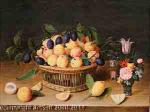Jacob Van Hulsdonck
Jacob Van Hulsdonck
Place: Antwerp
Born: 1582
Death: 1647
Biography:
Jacob van Hulsdonck or Jan van Hulsdonck it is difficult to establish a chronology of his works. Panel makers' marks are of little help in dating his work because of his preference for panels prepared with gesso on the reverse, which makes the wood more stable and less susceptible to warping. It is believed that his earliest still lifes are the ones in which the edge of the table is close to the bottom of the picture and the table is depicted from a rather elevated viewpoint. In these early works, the table is partly covered with a white cloth. In his later works he abandoned some of the rigidity of these early works by lowering the viewpoint, leaving some space under the table and including one side of the table in the composition. His palette is also believed to have evolved over the years and his later works have brighter colours and less dark backgrounds. His later still lifes are set out on plain wooden tables. The grain of the wood is typically depicted in great detail. Occasionally these tables are partly covered with a dark (greyish- or greenish-black) cloth.
Although he must have been familiar with the work of the Bosschaert studio, his work shows more affinity with the work of Osias Beert and even Hieronymous Francken II, two still life artists active in early 17th century Antwerp. It is even possible that van Hulsdonck worked in their circle before becoming a master in the Guild of Saint Luke in 1608. His flower pieces show the influence of Jan Brueghel the Elder.
Whereas 17th-century still lifes are usually believed to convey a hidden ‘message’, often related to the vanitas motif of the transience of all things, in van Hulsdonck’s works this seems to have been largely absent. Van Hulsdonck did, however, often include a bluebottle as an eye-catching motif and the only living creature in his still lifes. Flies are often regarded as a symbol of the shortness of life.
The banquet pieces of van Hulsdonck typically depict one bowl or basket of fruit in the center. There are six examples where he placed a small vase of flowers to one side of the bowl. The fruits are usual freshly picked plums, grapes, apricots or strawberries, although there is an example of a painting, the Still life with raisins, apricots and plums in a porcelain dish, which depicts dried fruit and nuts.
Van Hulsdonck was particularly skilled in rendering the softness and delicacy of the skins of the fruit. He was a master in bringing out the difference of texture and colouring of the various types of fruit and their foliage.
Van Hulsdonck also painted pure flower still lifes although they account for a much smaller portion of his oeuvre. Only a few of these are signed and have therefore sometimes been attributed to other artists. For instance, the work Still life of tulips, carnations, a rose and other flowers in a glass beaker resting on a wooded ledge (sold at Sotheby's on 3 July 2013 in London, lot 23) was previously attributed to Jan van Kessel the Elder. His flower pieces can be regarded as a precursor of van Kessel’s work as well as that of Daniel Seghers.
A few of his flower pieces only depict a single variety of flowers such as carnations, but most of the time he painted a mixture of a restricted number of blooms in which tulips dominate. The flowers are typically set against a dark background and are held in simple clear glass beakers with prunts in the lower register only, in order to allow the stems of each flower to be followed through to the base. His flower pieces show a greater formal elegance and refined simplicity than Brueghel's usually more elaborate flower pieces. This may possibly be due to Bosschaert's formative influence.
More...
Wikipedia link: Click Here














